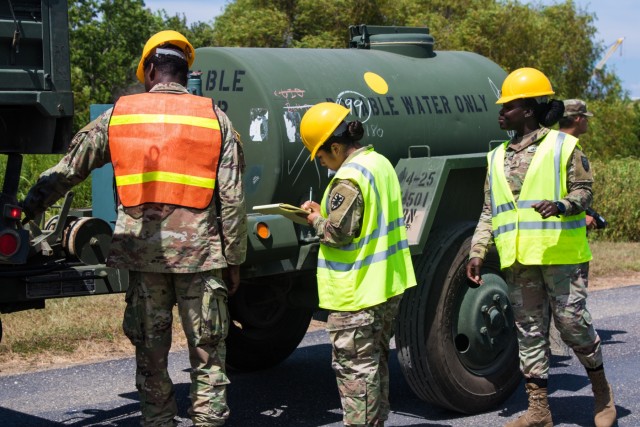When putting together a puzzle, one must understand how all of the pieces fit together and create the bigger picture. Each puzzle piece is a separate entity and contributes to the completion of the whole subject.
Planning and executing a large scale Joint Readiness Exercise (JRE) is very similar to the process of putting a puzzle together. The puzzle of JRE 2019 started in Alaska and culminated in Mississippi between Sept.13, 2019 and Sept. 19, 2019.
You start with the corner pieces. In the case of the JRE, the corner pieces were found in Port of Anchorage, Anchorage, Alaska. Here, Airmen and Soldiers from Joint Base Elmendorf-Richardson (JBER) worked with the Army Surface Deployment & Distribution Command's 833d Transportation Battalion to move approximately 1,450 vehicles and 440 containers of equipment from JBER to the Port of Anchorage.
This was the foundation of the JRE and lead into the next phase of the operation. In the Port of Anchorage, vehicles and equipment were loaded onto National Defense Reserve Fleet vessels, the MV Cape Rise and MV Cape Hudson, and then swiftly transported to Gulfport, Mississippi and Pascagoula, Mississippi.
Once in Mississippi, units with the 7th Transportation Brigade and Joint Task Force-Port Opening begin multiple capabilities scenarios where a port is rapidly created in either deteriorated port situations or situations where there is no port at all.
"Logistics Over-The-Shore (LOTS) exercises test and increase proficiency in the ability to take combat forces and bring them into a degraded port, or potentially conducting a beach landing and projecting that force onto land in a very short amount of time," said Lt.Col. Damien Boffardi, Task Force 11 Commander.
Doing this type of an exercise requires teamwork and collaboration from all of the Department of Defense military branches. All of which provided help in different aspects of this large scale JRE.
"As an Army we know that we will never go to war alone," said Maj. Christopher Fields, commander, 690th Rapid Port Opening Element. "We know that we will always go as a joint task force with our Navy, Airforce and Marine counterparts. We know that they provide certain capabilities that the Army can't provide and working together is imperative."
The JRE allows the Army to train transportation units, which are essential for deploying U.S. combat power around the world. It also demonstrates the cohesion between the Department of Defense military branches and their ability to deploy world-wide on short notice.
In Pascagoula, the LOTS operation begins as the vehicles and equipment are unloaded from the MV Cape Rise and transported to land.
"Every job in the army has its own unique value," said Pfc. Jordan Elicier, watercraft operator, Task Force 11, 7th Transportation Brigade (Expeditionary). "Part of the puzzle is transportation. You have to move everything where it needs to go. Everyone thinks the pieces of the puzzle just get dropped into place. No one ever really thinks about how things get to each location."
Elicier is an integral part of the large scale operation. The Merriam-Webster definition of integral is, essential to completeness. If you lose a puzzle piece or bend it out of its original shape, the picture cannot be completed. In the same sense, all of the Soldiers in a large scale operation must execute their portion of the puzzle in order for the mission to be complete.
From the loading of the vessels in Alaska, the maintaining and sailing of the ships to Mississippi, to the unloading of the equipment onto land and transporting it to Camp Shelby, Mississippi, each step requires a different unit to work together in order to complete the bigger operation.
Elicier is a watercraft operator on U.S. Army Vessel New Orleans, Landing Craft Utility 2031. These smaller army ships are used to transport the vehicles and equipment off of MV Cape Rise and onto Singing River Island in Pascagoula. From there a convoy is staged and transported to Camp Shelby.
Ultimately, the equipment travels from Anchorage, Alaska to Camp Shelby to support the 3,500 Soldiers of the 4th Infantry Brigade Combat Team (Airborne), 25th Infantry Division, who are set to participate in exercise Arctic Anvil.
The Army is a globally responsive force ready to deploy at a moment's notice and readiness is the Army's number one priority. JRE's like this one are fantastic opportunities for the military to assess its overall readiness and test its ability to deploy worldwide in a short amount of time.
"The Army plays a pivotal role in keeping logistical supplies flowing inland
from the shore," Boffardi said. "Exercising these capabilities increases readiness and ensures mission success in Littoral Operations in Contested Environments (LOCE). Exercising our capabilities helps sharpen our craft and better prepares our Soldiers for the future."
























Social Sharing